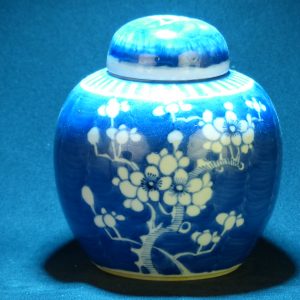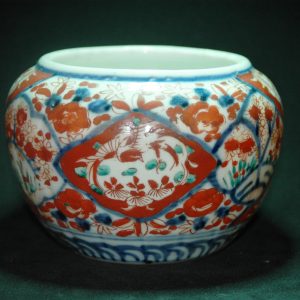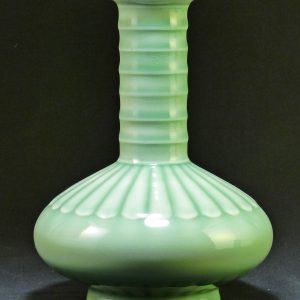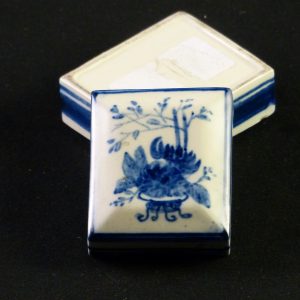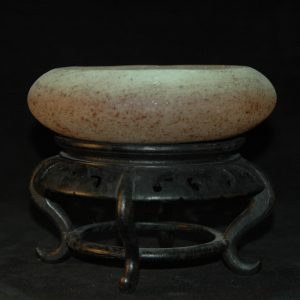Description
清康熙 豇豆红釉镗锣水洗
参考:佳士得
現場拍賣 17646
2019年9月12日
芝加哥藝術博物館珍藏中國瓷器及工藝精品
拍品 728 清康熙 豇豆紅釉鐺鑼洗 三行六字楷書款
A PEACHBLOOM-GLAZED BRUSH WASHER, TANGLUO XI
KANGXI SIX-CHARACTER MARK IN UNDERGLAZE BLUE AND OF THE PERIOD (1662-1722)
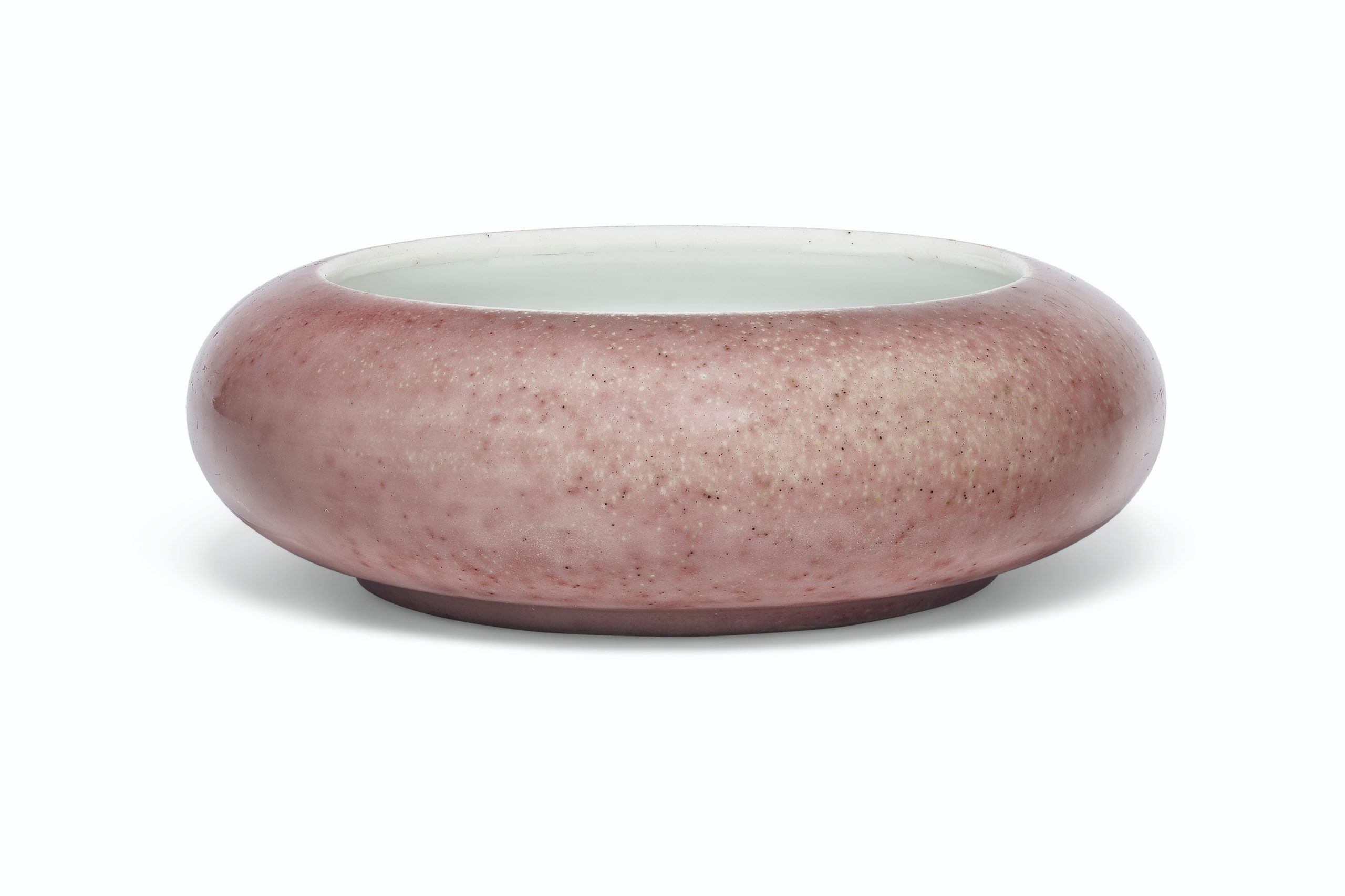
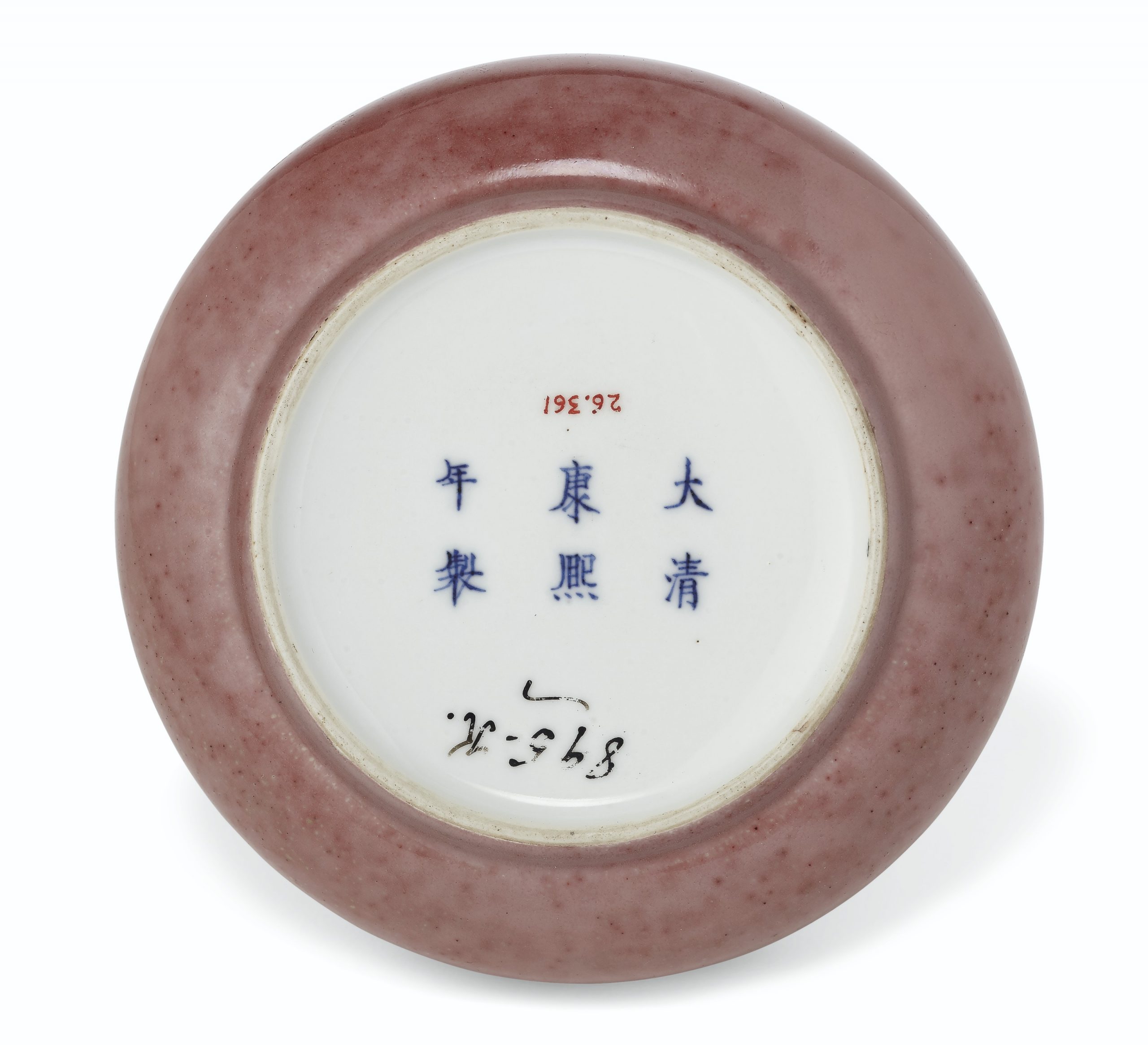
成交價 美元 27,500
估價 美元 30,000 – 美元 50,000
清康熙 豇豆紅釉鐺鑼洗 三行六字楷書款
4 5/8 in. (11.6 cm.) diam.
來源
Kate Sturges Buckingham (1858–1937) Collection, Chicago, before 1926.
The Art Institute of Chicago, accessioned as the Collection of Lucy Maud Buckingham (1870-1920) in 1926.
狀況報告
– 一條約 3.5 公分長的口沿細微裂痕延伸至下半身,還有幾處非常細微、短小的裂痕和口沿上的細小凹痕
– 口沿有一處缺口,且口沿已經經過輕微打磨
– 底部稍微磨薄,足圈上有一處細微、短小的裂痕
– 一側口沿下方有水平釉面間隙
– 內部有預期的表面磨損和輕微刮痕
– 內部和底部有幾處小爆氣孔
拍品專文
For discussion of peachbloom glaze and form of these brush washers(tangluo xi), see the footnote to lot 726.
参考:佳士得
現場拍賣 17646
2019年9月12日
芝加哥藝術博物館珍藏中國瓷器及工藝精品
拍品 730 清十八/十九世紀 豇豆紅釉鐺鑼洗
A PEACHBLOOM-GLAZED BRUSH WASHER, TANGLUO XI
18TH-19TH CENTURY
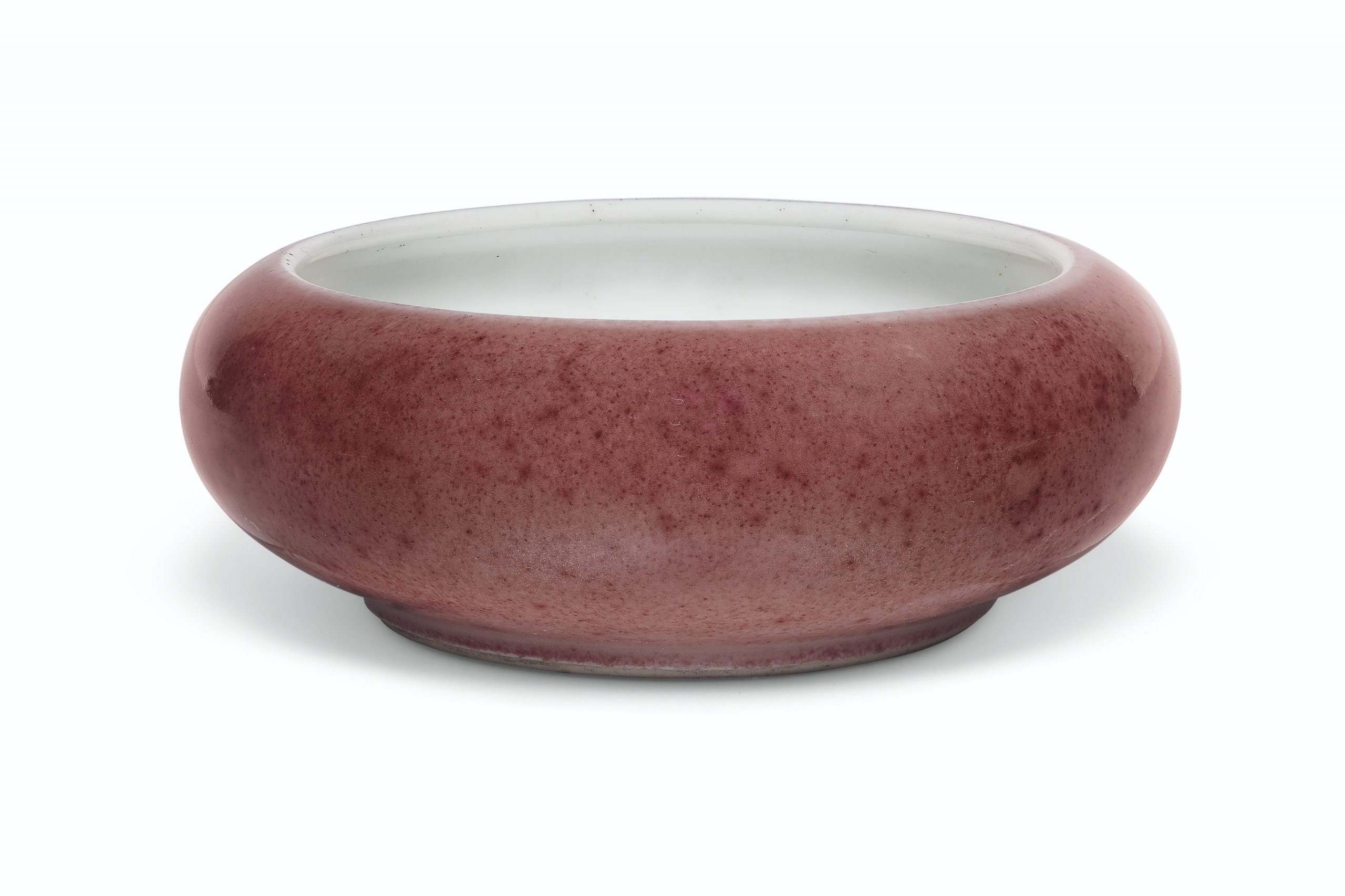
成交價 美元 6,875
估價 美元 4,000 – 美元 6,000
清十八/十九世紀 豇豆紅釉鐺鑼洗
18TH-19TH CENTURY
4 5/8 in. (11.8 cm.) diam.
來源
Kate Sturges Buckingham (1858–1937) Collection, Chicago, before 1926.
The Art Institute of Chicago, accessioned as the Collection of Lucy Maud Buckingham (1870-1920) in 1926.
拍場告示
Please note that this lot is being offered without a reserve.
狀況報告
– 口沿有一處小撞擊,幾處微小凹痕和坑洞
– 內部有幾處小釉面破洞和微小的釉料間隙
– 足圈上有幾處小凹痕和微小的淺缺口,且足圈已經打磨
– 底部有幾處微小的釉料間隙和幾處微小的針孔
参考:佳士得
7月 24日 2020年 | 網上拍賣 18417
中國瓷器及工藝精品
拍品 24
佛蒙特州私人遺產
清康熙 豇豆紅釉鐺鑼洗 三行六字楷書款
KANGXI SIX-CHARACTER MARK IN UNDERGLAZE BLUE AND OF THE PERIOD (1662-1722)
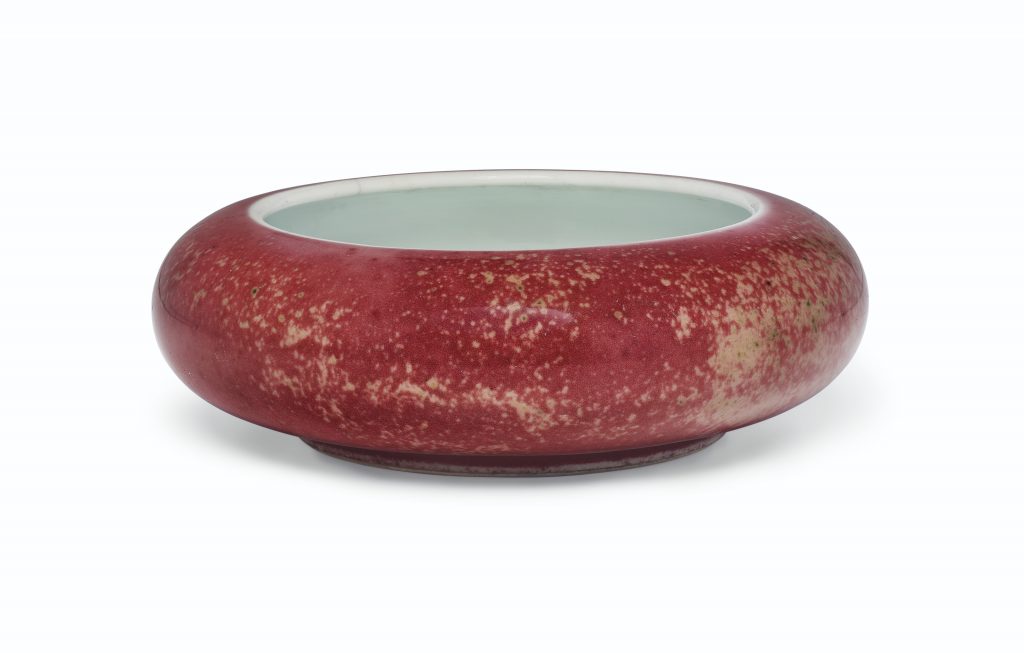
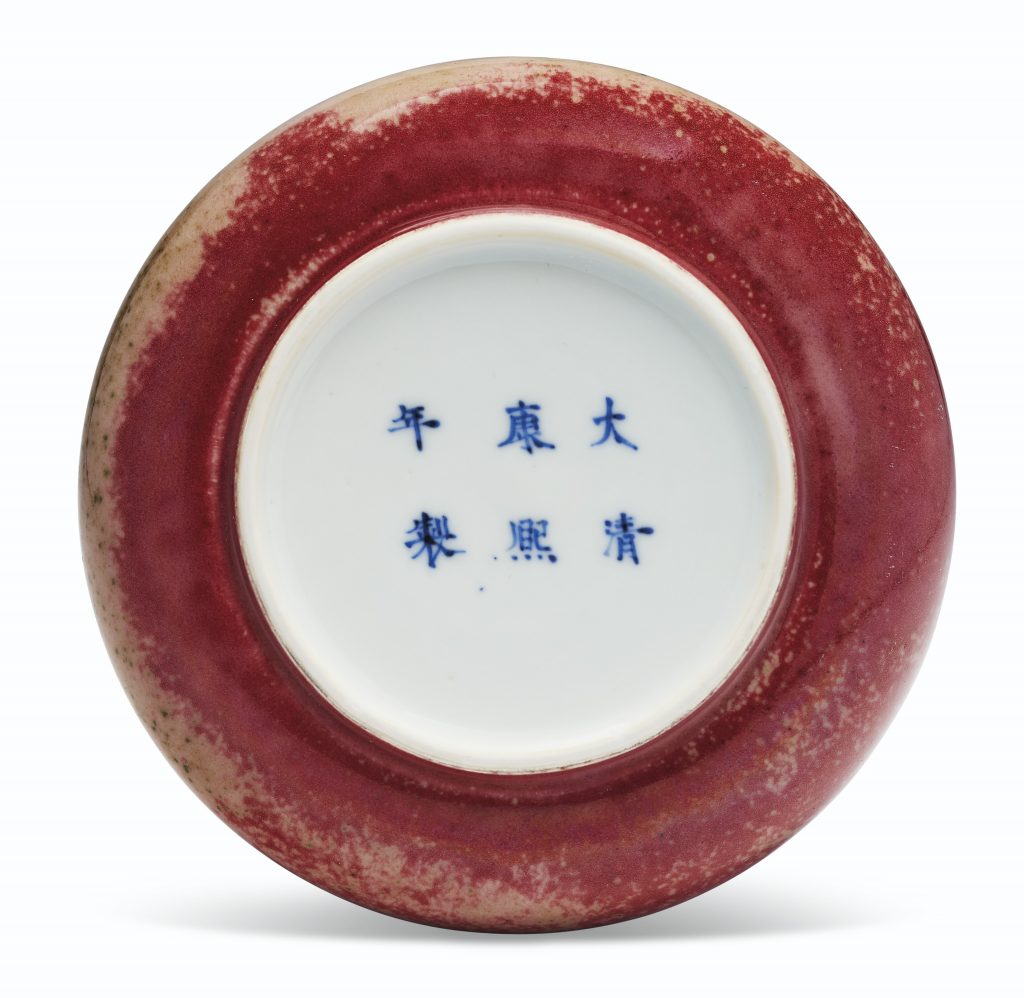
成交價 USD 37,500
估價 USD 20,000 – USD 30,000
詳情
47⁄8 in. (12.4 cm.) diam.
來源
Dudley Leavitt Pickman (1850-1938) 珍藏,波士頓。
Dudley Leavitt Pickman Jr. (1885-1964) 珍藏,波士頓。
Edward Motley Pickman (1886-1959) 珍藏,波士頓,後家族傳承。
狀況報告
拍品的狀況可能存在極大差異,而由於其性質使然,拍品難以處於完美無瑕的狀態。拍品均以拍賣時的狀況出售。
謹請注意,所有拍品均按「現狀」拍賣,閣下或閣下的專業顧問應於拍賣前親自查看拍品以評鑑拍品之狀況。
– 有四沖線,最長者自口沿延伸至器身(約長4.5公分),口沿另有少許不明顯之短驚釉
– 足沿稍經打磨,有兩相關小細磕及少許細小微磕
拍品專文
这个笔洗属于康熙时期制作的一组器物之一,采用了豇豆紅釉,通常被称为“八大码”,是书房用器,包括像这个例子一样的洗笔器。纽约大都会艺术博物馆收藏的一套代表这些形状的八个豇豆紅釉器物,由S. Valenstein在《中国陶瓷手册》(New York, 1989, p. 237)中有所描述。
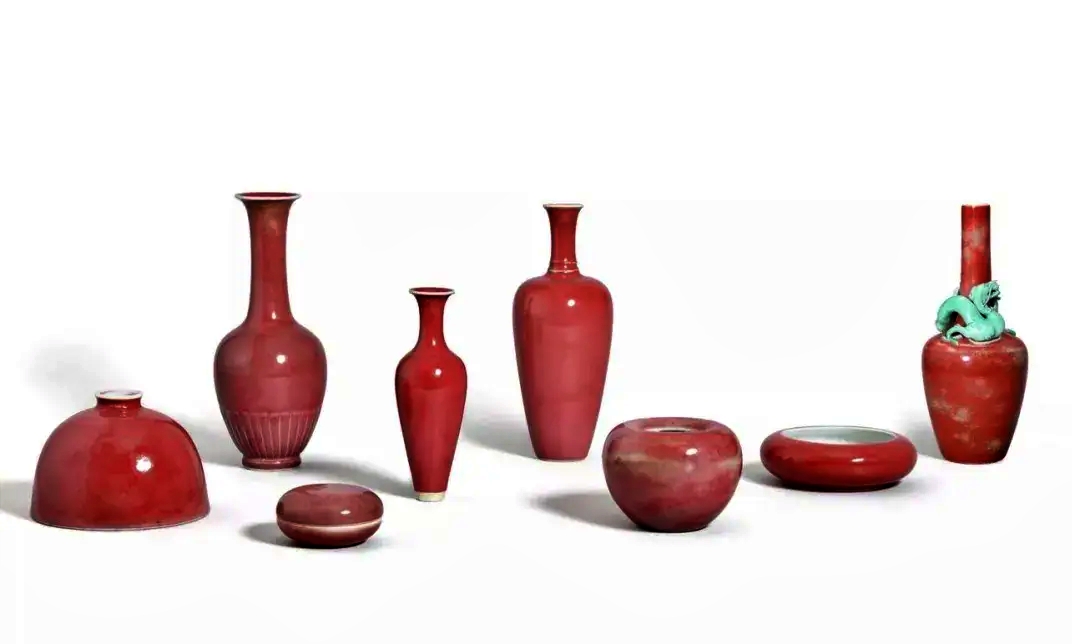
这种类型的洗笔被描述为“锣”形,或称为镗锣洗(washer of gong form),因其具有非常压缩的身体。其他康熙豇豆紅釉笔洗包括S. Jenyns在《后期中国瓷器》(London, 1904, pl. 7, fig. 1)中所示的一件;由M. Beurdeley和G. Raindre在《清代瓷器》(Fribourg, 1986, pl. 98)中所示的一件;由J. Ayers在《包尔收藏中国陶瓷》(Chinese Ceramics in the Baur Collection, vol. III, Geneva, 1972)中所示的A 306和A 309号;在《世界陶瓷全集》(Sekai toji zenshu, vol. 15, Tokyo, 1983, p. 34, no. 27)中所示的一件;还有另一件列在《伦敦大英博物馆中国明清单色陶瓷图录》(Illustrated Catalogue of Ming and Ch’ing Monochrome in the Percival David Foundation of Chinese Art, London, 1973, no. B 582)中(未图示)。另外,一件更多的康熙桃花源釉洗笔器曾在1978年香港艺术博物馆的展览《潮氏家族基金会藏明清瓷器》(Ming and Ch’ing Porcelain from the Collection of the T. Y. Chao Family Foundation)中展出,编号为53。
至于拍卖中售出的三个例子,包括康熙豇豆紅釉洗笔器,源自Edward T. Chow收藏,于2008年3月19日在纽约佳士得拍卖,拍品编号636;一件于2016年9月15日在纽约佳士得拍卖的笔洗,来源于玛丽·斯蒂尔曼·哈克内斯(Mary Stillman Harkness,1874-1952)收藏,拍品编号914,拍品名称为“在美国收藏:纽约大都会艺术博物馆的中国陶瓷”(Collected in America: Chinese Ceramics from The Metropolitan Museum of Art);还有一件于2019年9月12日在纽约佳士得拍卖的笔洗,来源于凯特·斯特吕吉斯·巴克汉姆(Kate Sturges Buckingham,1858-1937)收藏,拍品编号726,拍品名称为“芝加哥艺术学院藏中国艺术”(Chinese Art from The Art Institute of Chicago)。
The present washer belongs to a group of vessels covered in a peachbloom glaze, often referred to as the ba da ma or “The Eight Great Numbers”, made for the scholar’s desk during the Kangxi period, which include washers such as the present example. A set of eight peachbloom-glazed vessels representing these shapes in The Metropolitan Museum of Art, New York, is illustrated by S. Valenstein in A Handbook of Chinese Ceramics, New York, 1989, p. 237.
This type of brush washer is described as being of ‘gong’ shape, or tangluo xi (washer of gong form), as it has a very compressed body. Other Kangxi peachbloom brush washers include one illustrated by S. Jenyns in Later Chinese Porcelain, London, 1904, pl. 7, fig. 1; by M. Beurdeley and G. Raindre, Qing Porcelain, Fribourg, 1986, pl. 98; by J. Ayers, Chinese Ceramics in the Baur Collection, vol. III, Geneva, 1972, nos. A 306 and A 309; in Sekai toji zenshu, vol. 15, Tokyo, 1983, p. 34, no. 27; and another is listed in the Illustrated Catalogue of Ming and Ch’ing Monochrome in the Percival David Foundation of Chinese Art, London, 1973, no. B 582 (not illustrated). A further Kangxi peachbloom brush washer was included in the 1978 Hong Kong Museum of Art exhibition, Ming and Ch’ing Porcelain from the Collection of the T. Y. Chao Family Foundation, no. 53.
For three examples sold at auction, see the Kangxi peachbloom washer from the Edward T. Chow Collection sold at Christie’s New York, 19 March 2008, lot 636; the brush washer sold at Christie’s New York, Collected in America: Chinese Ceramics from The Metropolitan Museum of Art,Christie’s New York, 15 September 2016, lot 914, which was formerly in the Mary Stillman Harkness (1874-1952) Collection; and the brush washer sold at Christie’s New York, Chinese Art from The Art Institute of Chicago, 12 September 2019, lot 726, which was formerly in the Kate Sturges Buckingham (1858-1937) Collection.
参考:佳士得
11 9月 2019 | 現場拍賣 17646
芝加哥藝術博物館珍藏中國瓷器及工藝精品
拍品 726 清康熙 豇豆紅釉鏜鑼洗 三行六字楷書款
A PEACHBLOOM-GLAZED BRUSH WASHER, TANGLUO XI
KANGXI SIX-CHARACTER MARK IN UNDERGLAZE BLUE AND OF THE PERIOD (1662-1722)
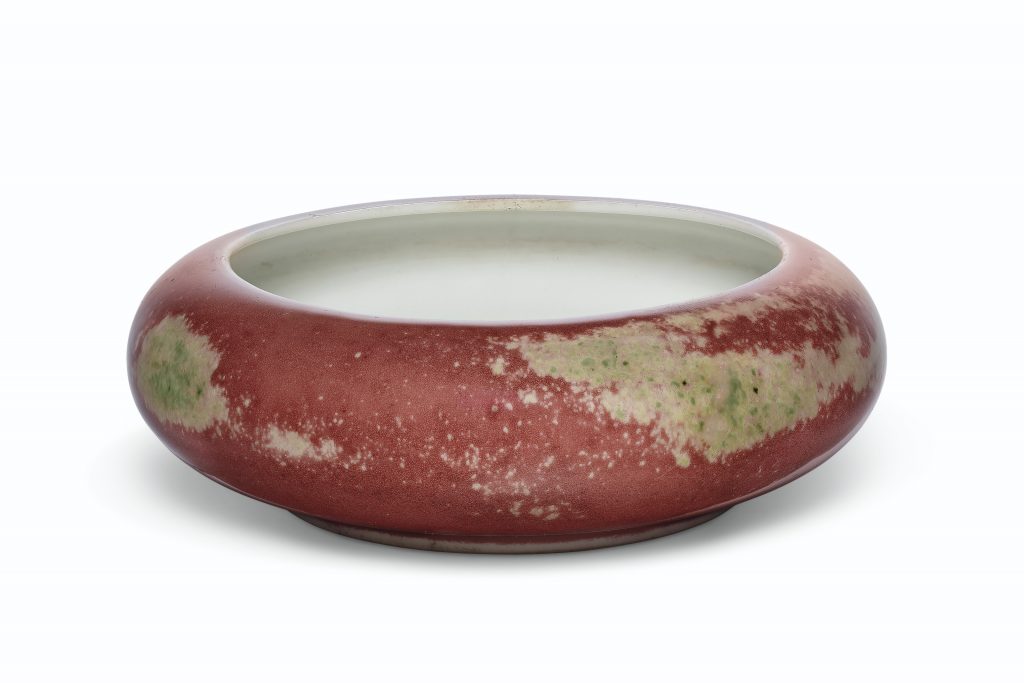
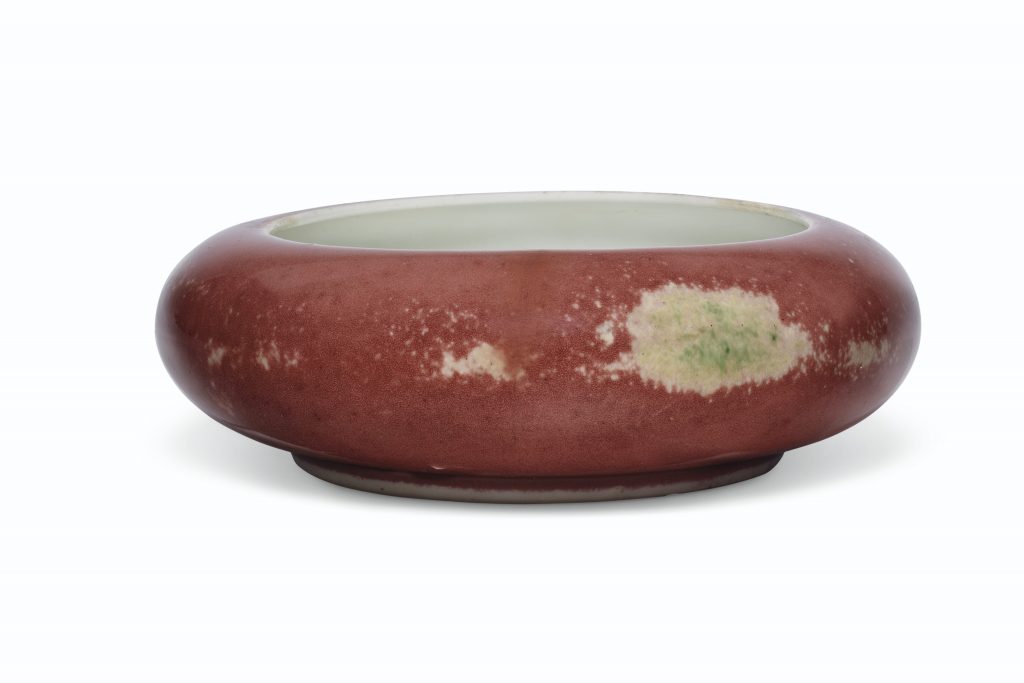
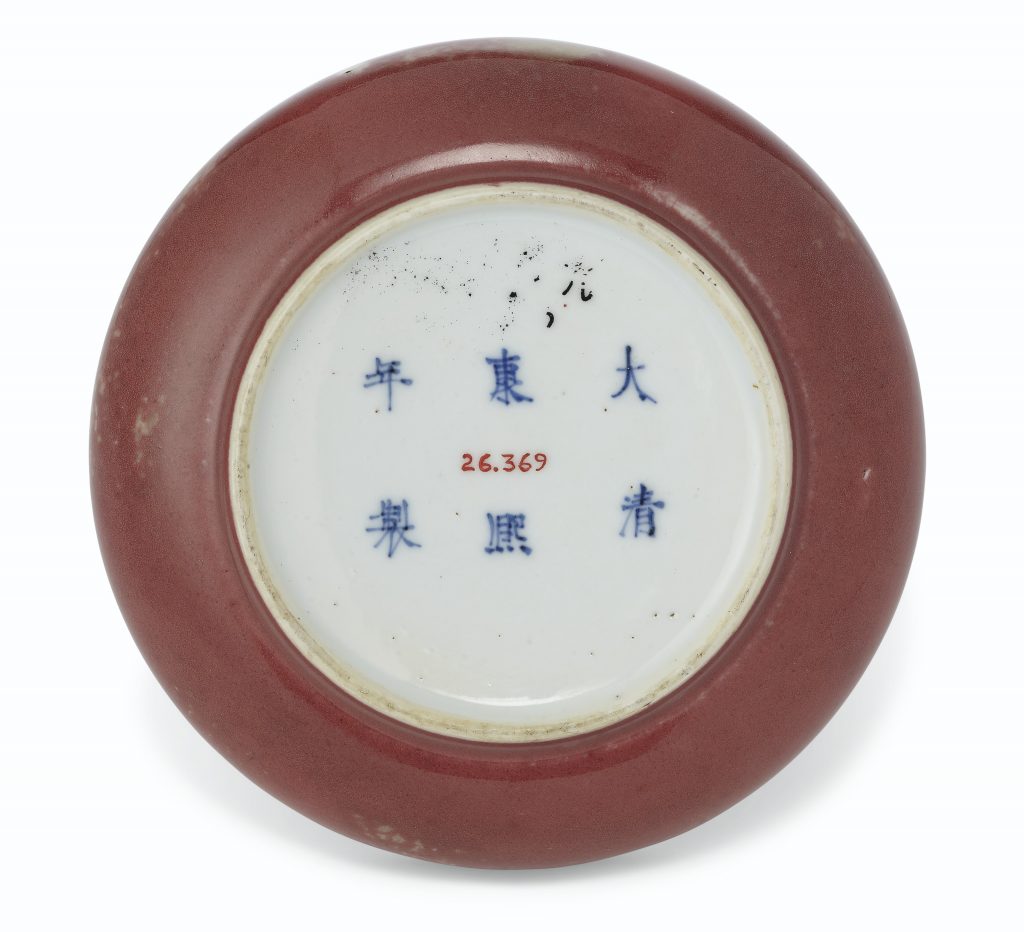
成交價 USD 81,250
估價 USD 40,000 – USD 60,000
清康熙 豇豆紅釉鏜鑼洗 三行六字楷書款
KANGXI SIX-CHARACTER MARK IN UNDERGLAZE BLUE AND OF THE PERIOD (1662-1722)
細節
清康熙 豇豆紅釉鏜鑼洗 三行六字楷書款
4 5/8 in. (11.7 cm.) diam.
來源
Kate Sturges Buckingham (1858–1937) Collection, Chicago, before 1926.
The Art Institute of Chicago, accessioned as the Collection of Lucy Maud Buckingham (1870-1920) in 1926.
拍品專文
The present washer belongs to a group of vessels covered in peachbloom glaze, often referred to as ba da ma or “The Eight Great Numbers”, made for the scholar’s desk during the Kangxi period. Examples from this group include washers (such as the present example and lot 728), water pots (lot 727), seal paste boxes and vases (lot 729). A set of eight peachbloom-glazed vessels of various shapes in The Metropolitan Museum of Art is illustrated by S. Valenstein in A Handbook of Chinese Ceramics, New York, 1989, p. 237.
In her discussion of a Kangxi peachbloom-glazed ‘chrysanthemum’ vase (jupan ping), sold at Christie’s New York, Collected in America: Chinese Ceramics from the Metropolitan Museum of Art, 15 September 2016, lot 913, Rosemary Scott notes how this technically complex glaze was produced: “Both the overall soft pinkish-red of the glaze, and the areas of clear green which appear to a greater or lesser extent within it owe their hue to copper. Firing in a reducing atmosphere creates the red color, while re-oxidation creates the green. This was therefore a glaze which had to be applied very precisely and fired with great care. Research suggests that a copper-lime pigment was applied between two layers of colorless glaze. The copper-lime pigment was applied by blowing through a bamboo tube with fine silk gauze over the end, to achieve an effect similar to modern spraying techniques. This allowed the thickness of the copper-lime layer to be adjusted so that some areas would be thicker than others. In those thicker areas there was additional flux, which thinned the upper glaze layer and allowed the copper to re-oxidise and produce clear green. In the other areas, some of the pigment was undissolved in the glaze making it appear slightly opaque and yet smooth on the surface, while the majority of the copper did dissolve and produced a rich pinkish-red, and creating one of the most highly esteemed glazes from the Qing imperial kilns.”
This type of brush washer is described as being of ‘gong’ shape, or tangluo xi (washer of gong form), as it has a very compressed body. Other Kangxi peachbloom brush washers include one illustrated by S. Jenyns in Later Chinese Porcelain, London, 1904, pl. 7, fig. 1; by M. Beurdeley and G. Raindre, Qing Porcelain, Fribourg, 1986, pl. 98; by J. Ayers, Chinese Ceramics in the Baur Collection, vol. III, Geneva, 1972, nos. A 306 and A 309; in Sekai toji zenshu, vol. 15, Tokyo, 1983, p. 34, no. 27; and another is listed in the Illustrated Catalogue of Ming and Ch’ing Monochrome in the Percival David Foundation of Chinese Art, London, 1973, no. B 582 (not illustrated). A further Kangxi peachbloom brush washer was included in the 1978 Hong Kong Museum of Art exhibition, Ming and Ch’ing Porcelain from the Collection of the T. Y. Chao Family Foundation, no. 53.
For two examples sold at auction, see the Kangxi peachbloom washer from the Edward T. Chow Collection sold at Christie’s New York, 19 March 2008, lot 636, and the brush washer sold at Christie’s New York, Collected in America: Chinese Ceramics from The Metropolitan Museum of Art, Christie’s New York, 15 September 2016, lot 914, which was formerly in the Mary Stillman Harkness (1874-1952) Collection.
参考:佳士得
拍賣 2811
中國宮廷御製藝術精品、重要中國瓷器及工藝精品
Hong Kong|2010年5月31日
拍品1864 清康熙 豇豆紅鏜鑼洗 三行六字楷書款
A PEACHBLOOM-GLAZED BRUSHWASHER, TANGLUO XI
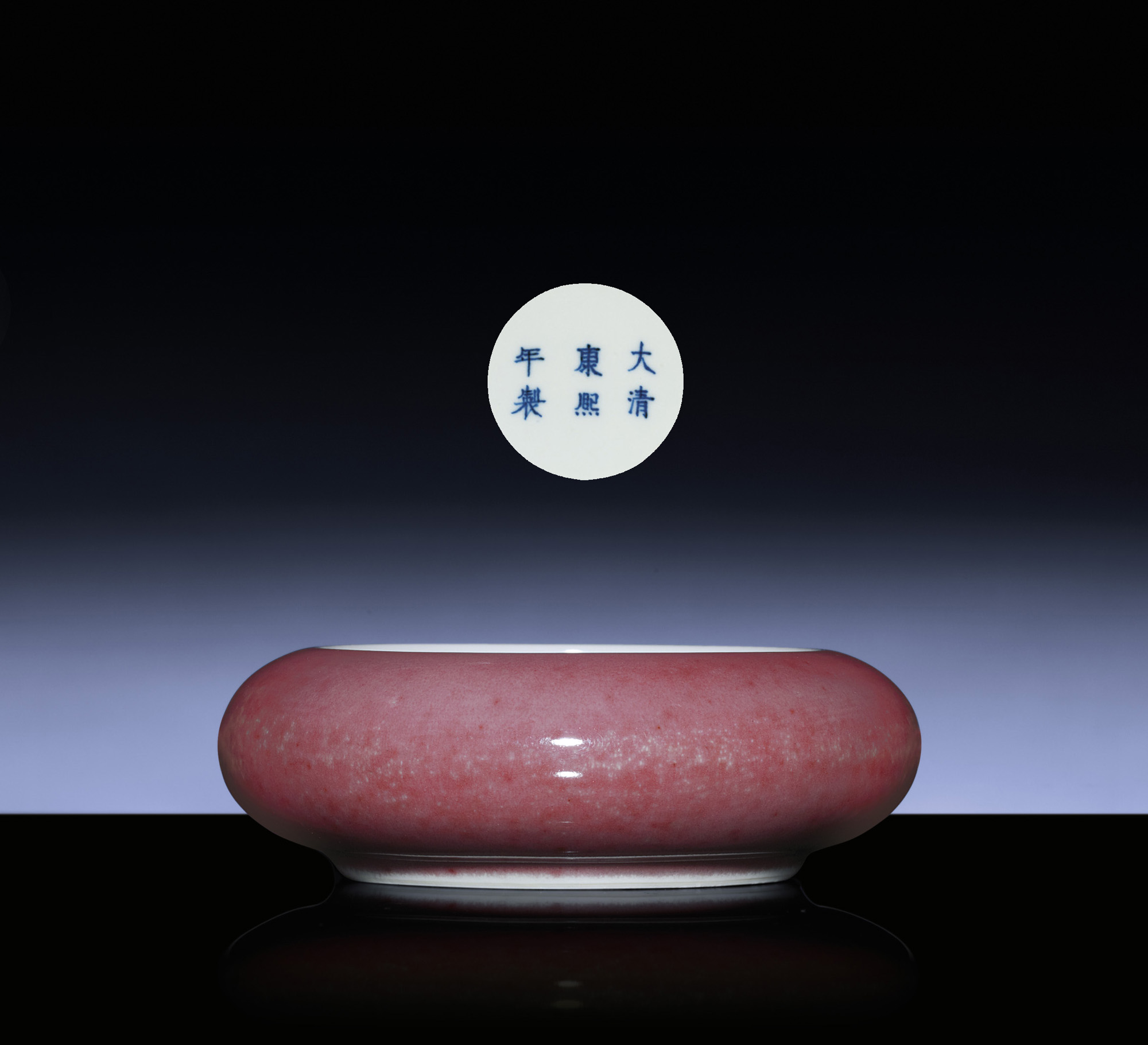
成交總額 HKD 860,000
估價 HKD 350,000 – HKD 450,000
年款右邊內足牆青花書「文」字。
來源
A private collection, Hong Kong
拍品專文
The brushwasher is described as of ‘gong-shape’ or tangluo xi, as it has heavily compressed sides.
This washer belongs to an exclusive group of eight vessel shapes that are embellished in this extremely desirable peachbloom glaze . Known as the ba da ma or ‘Eight Great Numbers’. The sets were especially devised in these classic forms to serve as requisite appointments for the Emperor’s writing table. Thus the character ‘wen’ appearing on the base, a contraction of ‘wen ju’, a term describing the items on a scholar’s desk, is highly appropriate for a brushwasher.
Similar brushwashers are illustrated by S. Jenyns in Later Chinese Porcelain, pl. 7, fig. 1; by J. Ayers, Chinese Ceramics in the Baur Collection, vol. III, Geneva, 1972, nos. A 306, A 309; in Sekai Toji Zenshu, vol. 15, no. 27.
参考:佳士得
拍賣 1154中國瓷器及工藝精品
倫敦|2013年11月5日
拍品457 清 康熙 桃红釉镗锣形笔洗
A PEACHBLOOM-GLAZED BRUSH WASHER,
TANGLUOXI KANGXI SIX-CHARACTER MARK IN UNDERGLAZE BLUE AND OF THE PERIOD (1662-1722)
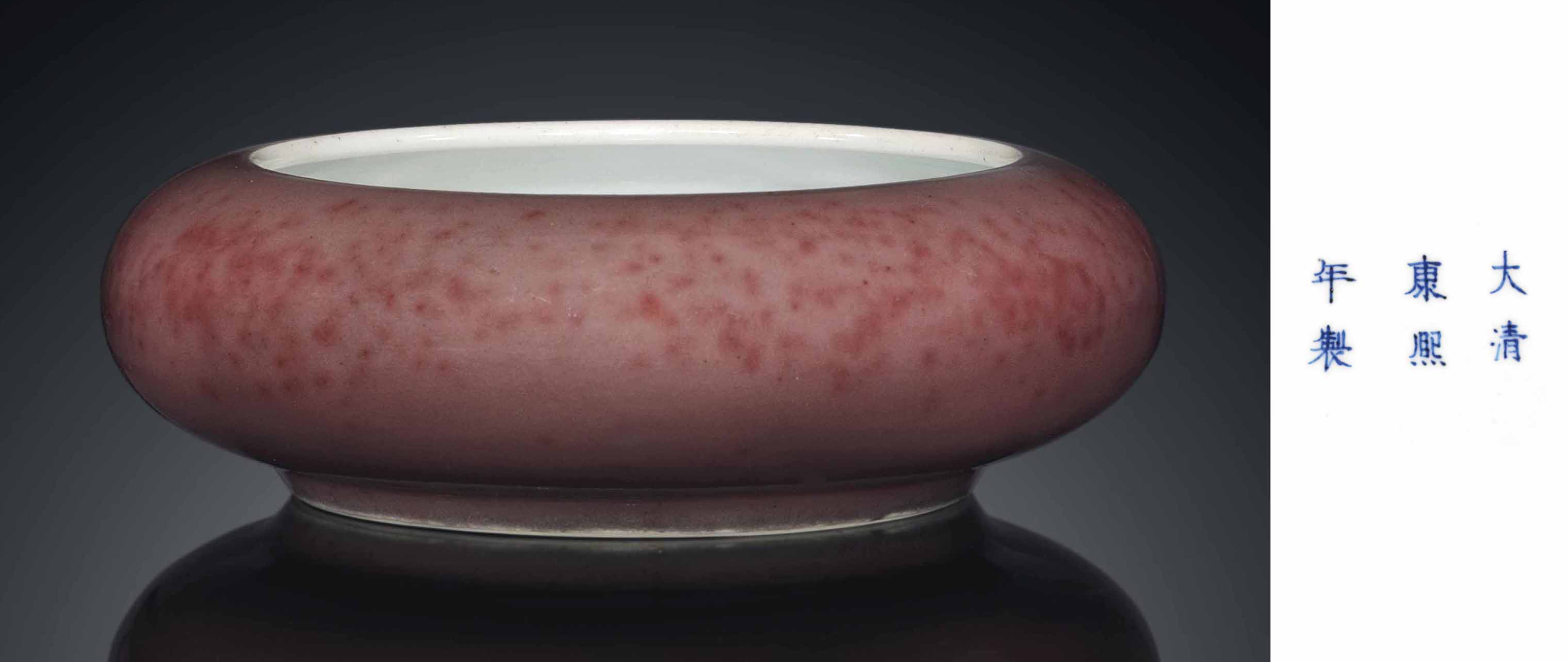
成交總額 GBP 74,500
估價 GBP 60,000 – GBP 80,000
A PEACHBLOOM-GLAZED BRUSH WASHER, TANGLUOXI
KANGXI SIX-CHARACTER MARK IN UNDERGLAZE BLUE AND OF THE PERIOD (1662-1722)
The globular vessel is of compressed form, supported on a short foot. The exterior is covered with a dark pink glaze, with strawberry-red flecks throughout. The interior and the base are glazed in white.
4½ in. (11.5 cm.) diam.
來源
Sotheby’s Hong Kong, 14 November 1989, lot 142.
Sotheby’s Hong Kong, 4 & 5 November 1997, lot 1519.
参考:佳士得
拍賣 3263重要中國瓷器及工藝精品
香港|2013年11月27日
拍品3488|THE PROPERTY OF A LADYA
清 康熙 桃红釉镗锣形笔洗
PEACHBLOOM-GLAZED BRUSH WASHER, TANGLUO XI KANGXI SIX-CHARACTER MARK AND OF THE PERIOD (1662-1722)
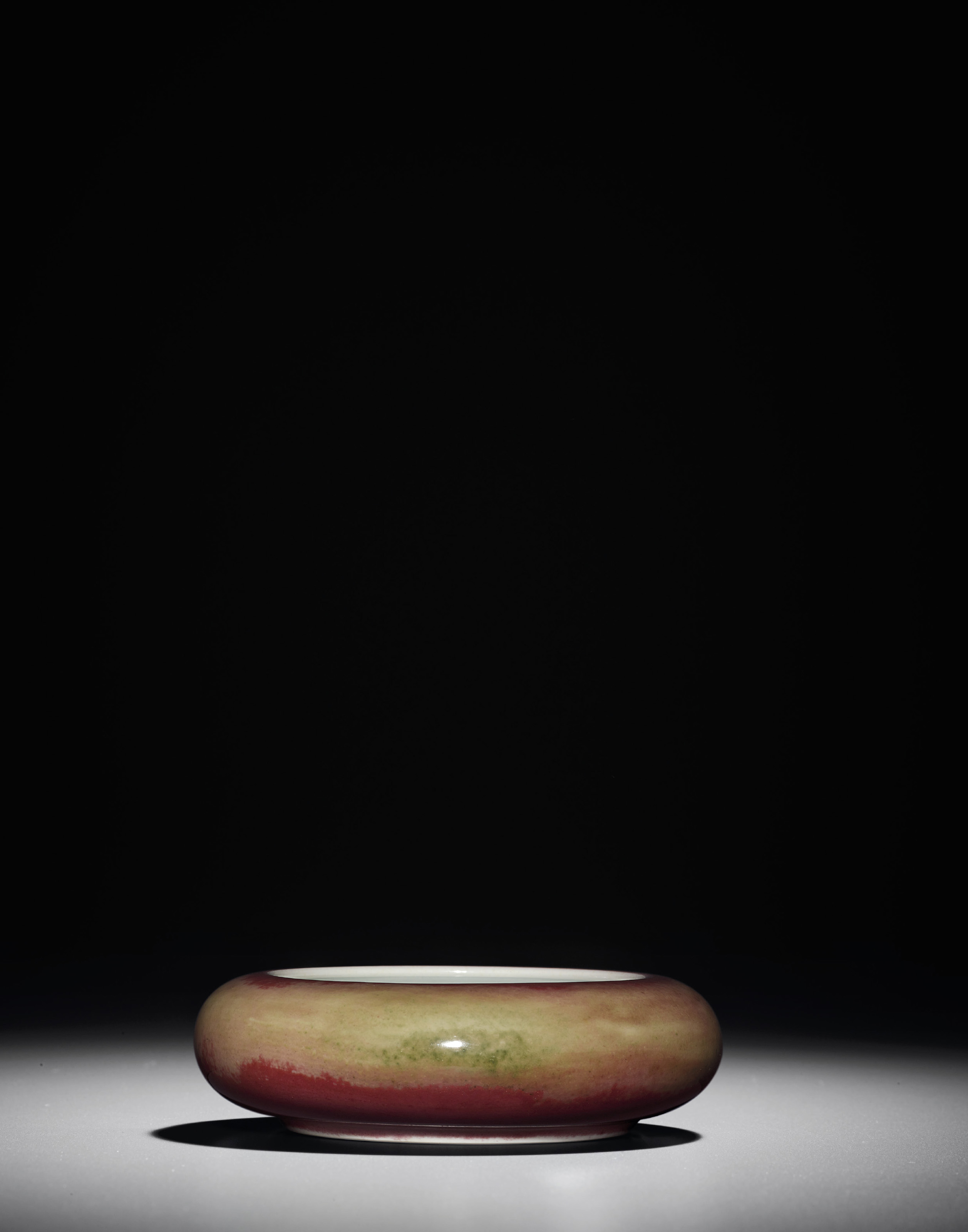
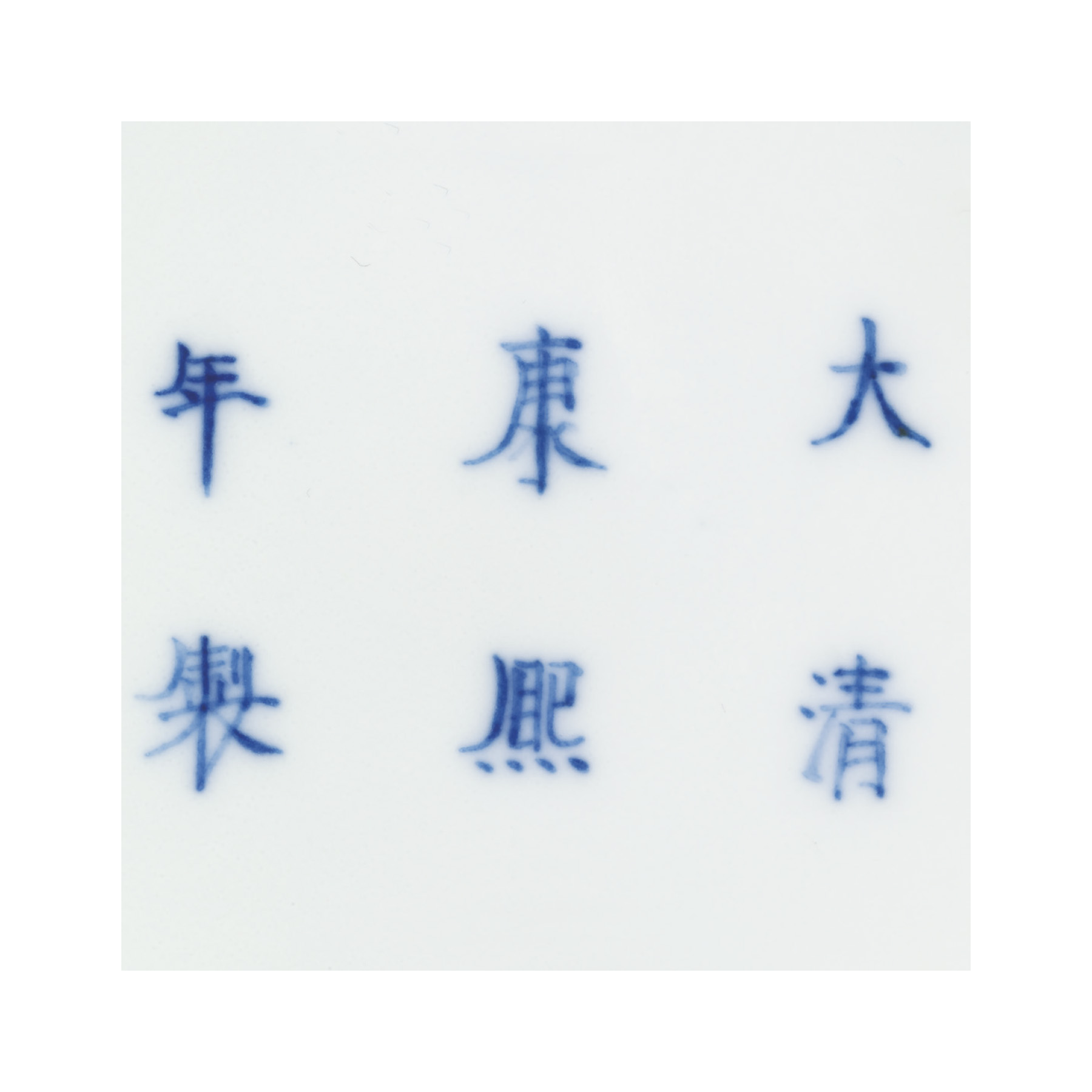
成交總額 HKD 1,360,000
估價 HKD 700,000 – HKD 900,000
A PEACHBLOOM-GLAZED BRUSH WASHER, TANGLUO XI
KANGXI SIX-CHARACTER MARK AND OF THE PERIOD (1662-1722)
The compressed globular body is covered on the exterior with a glaze of crushed strawberry-red and mottled greyish-green colour. The interior and base are white. The base is inscribed with the reign mark in underglaze blue.
4 7/8 in. (11.6 cm.) diam., box
來源
Mrs. Enid Lodge and Brodie Lodge, sold at Sotheby’s, London, 10 December 1968, lot 127
Sold at Sotheby’s, Hong Kong, 18-19 May 1982, lot 264
Sold at Christie’s New York, 16 September 2010, lot 1403
文獻及展覽
展覽
Monochrome Porcelain of the Ming and Manchu Dynasties, Oriental Ceramic Society, October 1948, no. 77
The Chinese Scholar’s Desk, 17th to 18th Century, Ashmolean Museum, Oxford, 1979, no. 24
拍品專文
This type of brush washer is described as being of gong shape, or tangluo xi, as it has a very compressed body. It belongs to a group of vessels referred to as the Badama, ‘Eight Great Numbers’. This group was previously thought to comprise a total of eight differing shapes. John Ayers identified a possible ninth form of the Badama by pointing out the existence of two slightly different globular water pots. The first is termed as a pingguo zun, ‘apple jar’ modelled with a gently inward curving mouth rim; and the other with a raised, low, neck (similar to a stalk) that maybe referred to as a Shi liu, or ‘Pomegranate jar’. See, J. Ayers, ‘The ‘Peachbloom Wares of the Kangxi Period (1662-1722), Transactions of the Oriental Ceramic Society, vol. 64, 1999-2000, p. 49.
Many of the world’s great museums have published similar examples of brush washers, including the Metropolitan Museum of Art, The Palace Museum, Beijing and the Sir Percival David Collection at the British Museum, London. The brush washer in the Metropolitan Museum is illustrated with a group of peachbloom-glazed vessels made for the scholar’s table, including a beehive water pot, illustrated by S. Valenstein, A Handbook of Chinese Ceramics, New York, 1989, rev. ed., p. 237, no. 236. Compare with examples of Kangxi-marked brush washers of this type sold at Christie’s New York, 15 September 2009, lot 445, and from the Y.C. Chen Collection, sold at Christie’s Hong Kong, 29 May 2013, lot 1905.
THE PROPERTY OF A LADY
参考:
拍卖 13753
美藏于斯 ─ 大都会艺术博物馆珍藏中国瓷器
纽约|2016年9月15日
拍品914 A PEACHBLOOM-GLAZED BRUSH WASHER, TANGLUO XI
KANGXI SIX-CHARACTER MARK IN UNDERGLAZE BLUE AND OF THE PERIOD (1662-1722)
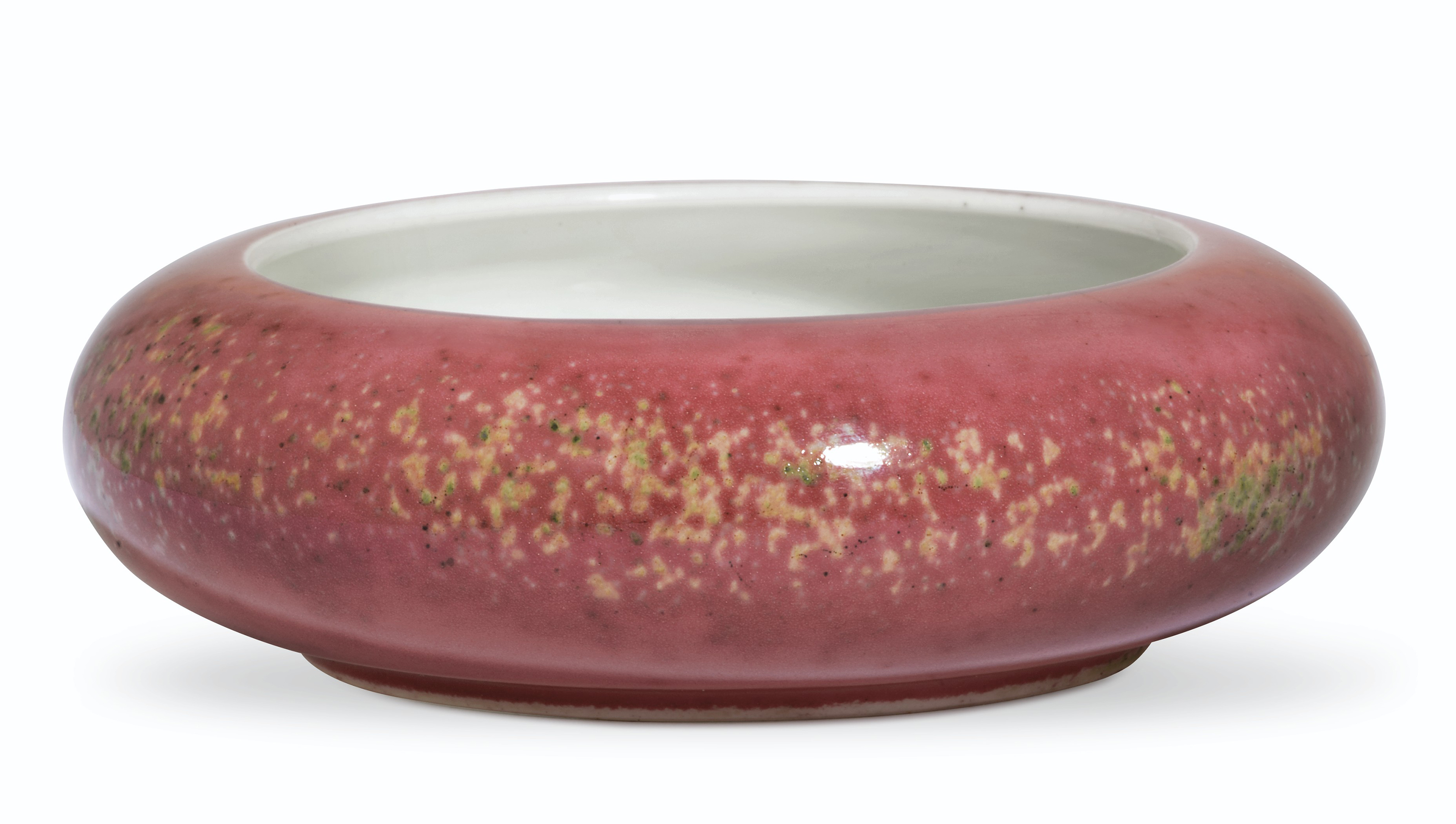
纽约|2016年9月15日
拍品914 A PEACHBLOOM-GLAZED BRUSH WASHER, TANGLUO XI
KANGXI SIX-CHARACTER MARK IN UNDERGLAZE BLUE AND OF THE PERIOD (1662-1722)
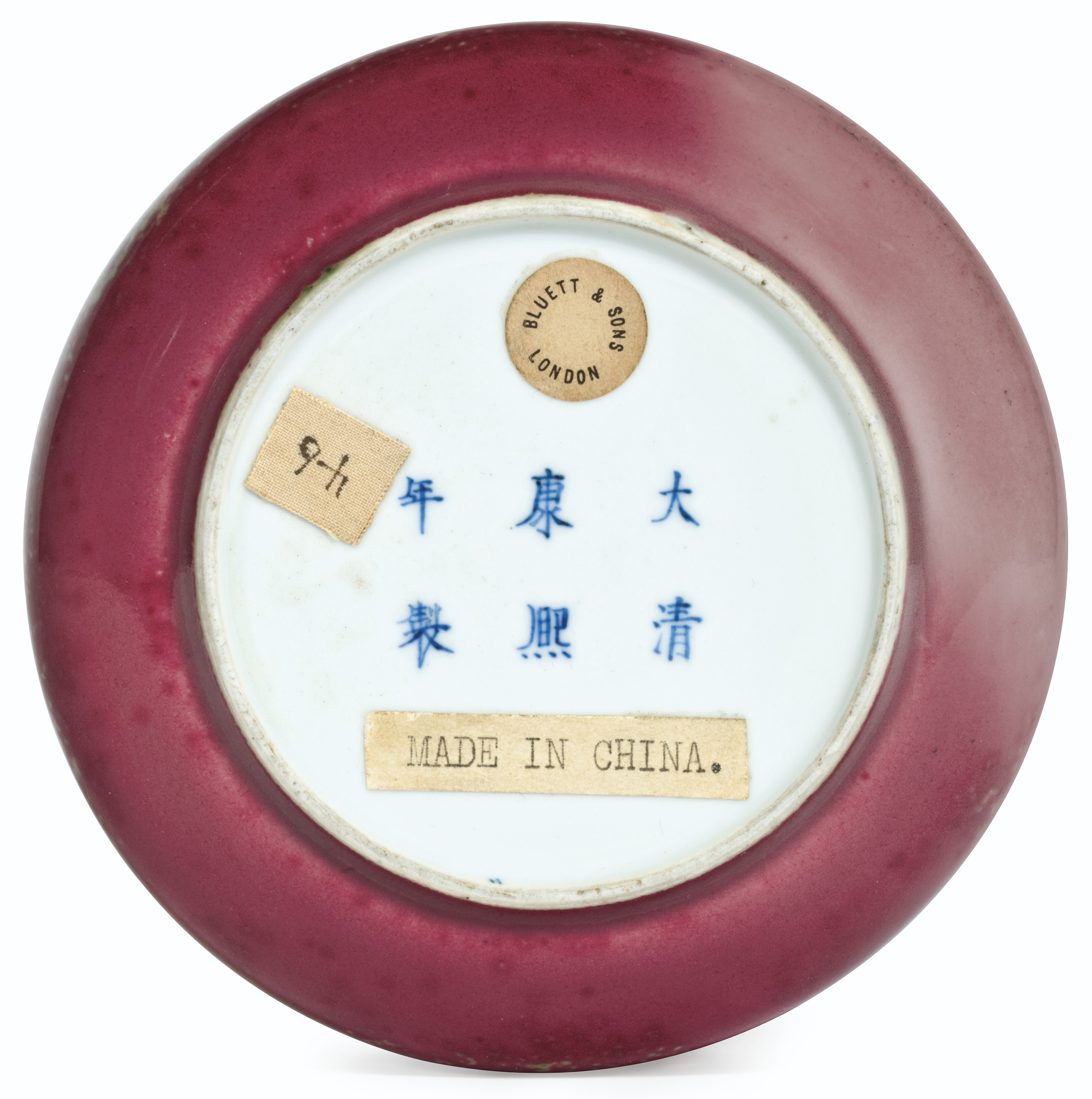
纽约|2016年9月15日
拍品914 A PEACHBLOOM-GLAZED BRUSH WASHER, TANGLUO XI
KANGXI SIX-CHARACTER MARK IN UNDERGLAZE BLUE AND OF THE PERIOD (1662-1722)
成交总额 USD 155,000
估价 USD 100,000 – USD 150,000
A PEACHBLOOM-GLAZED BRUSH WASHER, TANGLUO XI
KANGXI SIX-CHARACTER MARK IN UNDERGLAZE BLUE AND OF THE PERIOD (1662-1722)
The compressed globular body is covered on the exterior with a glaze of soft rose color suffused with pale green speckles and thinning to a pale pink tone on one side of the body. The interior and base are white.
3 ¼ in. (8.3 cm.) diam.
来源
Bluett & Sons, London (according to label).
Mary Stillman Harkness (1874-1952) Collection.
The Metropolitan Museum of Art, New York, accessioned in 1950.
拍品专文
This type of brush washer is described as being of ‘gong’ shape, or tangluo xi, as it has a very compressed body. Similar Kangxi peachbloom brush washers are illustrated by S. Jenyns in Later Chinese Porcelain, London, 1904, pl. 7, fig. 1; by M. Beurdeley and G. Raindre, Qing Porcelain, Fribourg, 1986, pl. 98; by J. Ayers, Chinese Ceramics in the Baur Collection, vol. III, Geneva, 1972, nos. A 306, A 309; in Sekai toji zenshu, vol. 15, Tokyo, 1983, p. 34, no. 27; and in the Illustrated Catalogue of Ming and Qing Dynasty Monochromes in the Percival David Foundation of Chinese Art, London, 1973, no. B 582. See, also, the washer of this type included in the 1978 Hong Kong Museum of Art exhibition, Ming and Ch’ing Porcelain from the Collection of the T. Y. Chao Family Foundation, no. 53. See, also, the peachbloom washer of this type from the Edward T. Chow Collection sold at Christie’s New York, 19 March 2008, lot 636.
For further discussion of peachbloom-glazed wares of the Kangxi period, see the note to lot 913.
参考:纽约大都会博物馆
清康熙 笔洗
Coupe
China
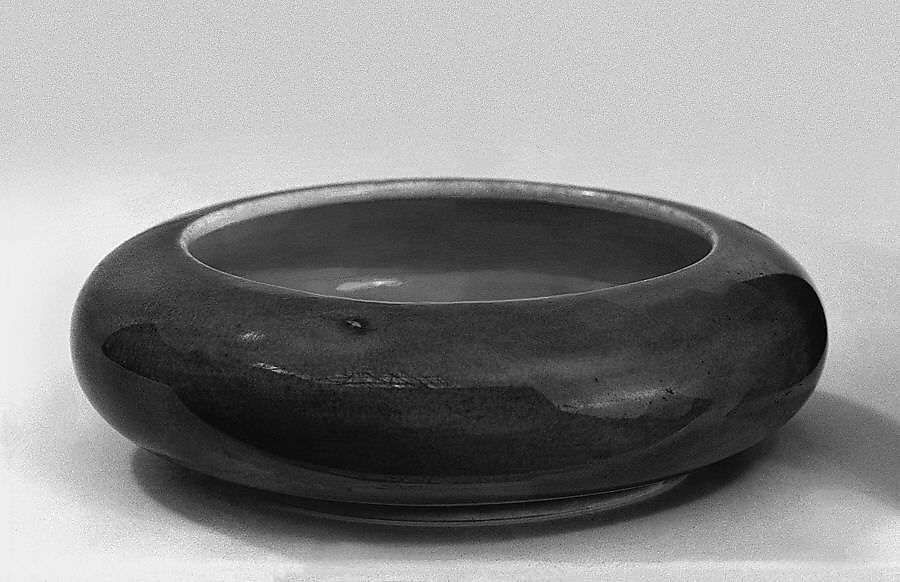
Object Details
Period:Qing dynasty (1644–1911), Kangxi period (1662–1722)
Culture:China
Medium:Porcelain with peachbloom glaze
Dimensions:H. 1 1/4 in. (3.2 cm); Diam. 4 1/2 in. (11.4 cm)
Classification:Ceramics
Credit Line:H. O. Havemeyer Collection, Bequest of Mrs. H. O. Havemeyer, 1929
Accession Number:29.100.354
Signatures, Inscriptions, and Markings
Marking: Kangxi (1662-1722), in six characters
Provenance
Mrs. H. O. (Louisine W.) Havemeyer , New York (until d. 1929; bequeathed to MMA)
Timeline of Art History
Timelines
Central and North Asia, 1600-1800 A.D.
China, 1600-1800 A.D.
参考:纽约大都会博物馆
清康熙 笔洗 Brush Washer
China

Object Details
Period:Qing dynasty (1644–1911), Kangxi period (1662–1722)
Culture:China
Medium:Porcelain with peachbloom glaze
Dimensions:H. 1 1/4 in. (3.2 cm); Diam. 4 1/2 in. (11.4 cm)
Classification:Ceramics
Credit Line:H. O. Havemeyer Collection, Bequest of Mrs. H. O. Havemeyer, 1929
Accession Number:29.100.353
Signatures, Inscriptions, and Markings
Marking: Kangxi (1662-1722), in six characters
Provenance
Mrs. H. O. (Louisine W.) Havemeyer , New York (until d. 1929; bequeathed to MMA)
Timeline of Art History
Timelines
Central and North Asia, 1600-1800 A.D.
China, 1600-1800 A.D.
参考:纽约大都会博物馆
清康熙 笔洗
Brush Washer



China
Derived from copper, lush pinkish-red glazes were first produced in the third quarter of the seventeenth century as part of experimentation at the Jingdezhen kilns. The delicate red and greenish spots that mottle the surface of this vessel are part of the appeal of this elegant and hard-to-make “peach bloom” glaze.
On view at The Met Fifth Avenue in Gallery 219
Object Details
Period:Qing dynasty (1644–1911), Kangxi mark and period (1662–1722)
Culture:China
Medium:Porcelain with peachbloom glaze (Jingdezhen ware)
Dimensions:H. 1 1/4 in. (3.2 cm); Diam: 4 1/2 in. (11.4 cm)
Classification:Ceramics
Credit Line:H. O. Havemeyer Collection, Bequest of Mrs. H. O. Havemeyer, 1929
Accession Number:29.100.352
Signatures, Inscriptions, and Markings
Marking: Kangxi mark, in six characters, reading “Da Qing Kangxi nianzhi”
Provenance
Mrs. H. O. (Louisine W.) Havemeyer , New York (until d. 1929; bequeathed to MMA)
Exhibition History
New York. The Metropolitan Museum of Art. “Extravagant Display: Chinese Art in the Eighteenth and Nineteenth Centuries,” December 14, 2010–May 1, 2011.
Timeline of Art History
Timelines
Central and North Asia, 1600-1800 A.D.
China, 1600-1800 A.D.
MetPublications
Splendid Legacy: The Havemeyer Collection
How to Read Chinese Ceramics
“Highlights of Chinese Ceramics”: The Metropolitan Museum of Art Bulletin, v. 33, no. 3 (Fall, 1975)
A Handbook of Chinese Ceramics
参考:保利厦门2017秋季拍卖会
玄览—重要古董器物专场
清康熙 豇豆红釉镗锣洗
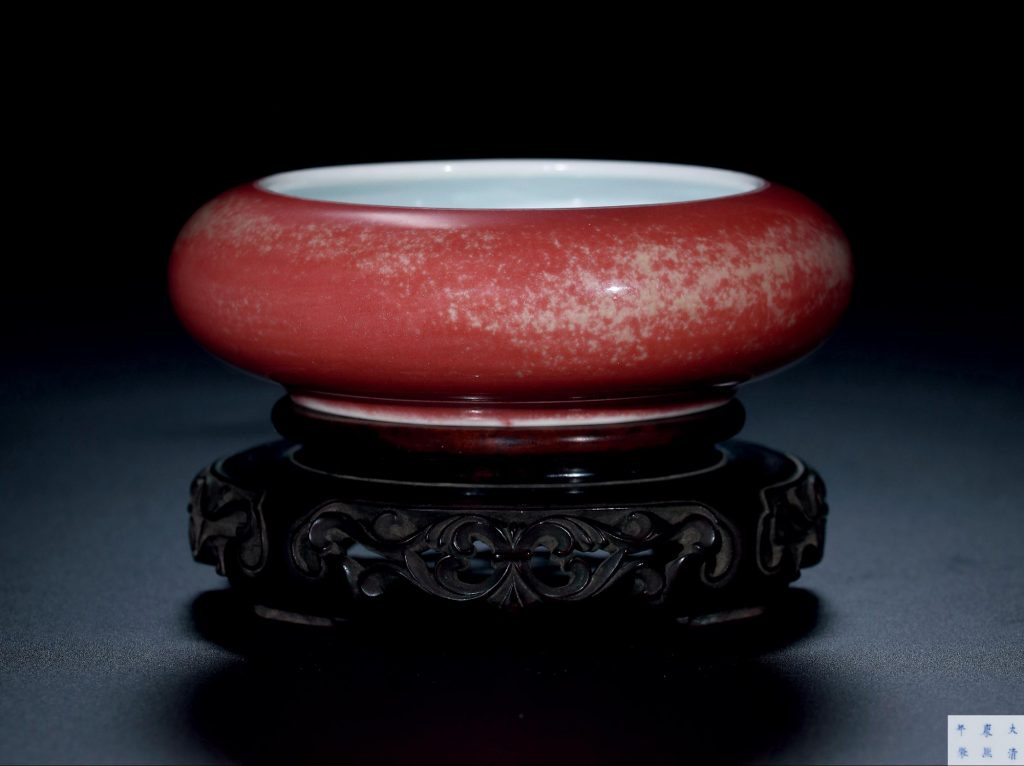
拍卖信息
Lot 0902 清康熙 豇豆红釉镗锣洗
估价:400,000-600,000 RMB
成交价: 920,000 RMB (含买家佣金)
尺寸: 直径11cm
拍品说明:
「大清康熙年制」六字三行楷书款 此洗呈镗锣式,敛口,扁腹,浅圈足,器型饱满圆润,线条流畅。内壁及外底部施白釉,色泛青白,外壁施豇豆红釉,娇柔粉嫩,点点绿苔缀于其间,所谓「满身苔点,泛于桃花春浪间」。《饮流斋说瓷》有云:「豇红之所以可贵者,在莹润无比,居若鲜若暗之间,妙在难以形容也。」其娇艳中又见温婉,「美人霁佳处在于淡红中显鲜红色与茶褐色之点,背光则显绿色」,故其又有美人醉、桃花片等名称。底落「大清康熙年制」六字楷书款,清雅大方。康熙朝豇豆红制器,常为八件一套,为皇帝御制文房用品,若色美者成套陈设,颇感震憾。惟豇豆红者品相悬殊,且民国时期大量仿制。可见其深受皇帝推宠,历史地位非同凡响,二十世纪七十年代,不重视清代收藏的日本藏家亦将其视为珍宝,称其为桃花面的传说。北京故宫博物院有清宫旧藏一例,上海文物商店藏有一例,可资比较。参阅:《故宫博物院藏文物珍品大系—颜色釉》,上海科学技术出版社、商务印书馆(香港)有限公司,1999年,页22,图19《清代瓷器赏鉴》,上海科学技术出版社,中华书局(香港)有限公司,1994年,页68,图69《世界陶瓷全集15》小学馆株式会社 P36《A Handbook of Chinese Ceramics》修订版,237页,图版236号《康熙瓷图录》 上海博物馆藏 P32《暂得楼清代官窑单色釉瓷器》 P40
来源
北京拍卖会
参考:保利香港2015年秋季拍卖会
2015-10-06
中国古董珍玩专场
清康熙 豇豆红釉镗锣洗
款识:「大清康熙年制」青花六字三行楷书款
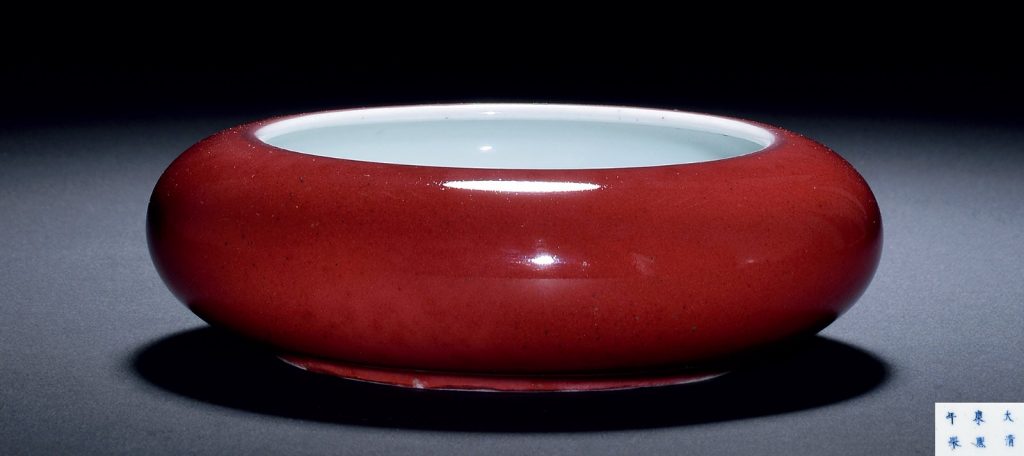
拍品信息
尺寸 直径12cm
估价 HKD 2,500,000-3,500,000
成交价 RMB 2,812,884 HKD 3,422,000USD 438,016EUR 342,200
说明
镗锣洗为康熙时期典型宫廷文房用具,敛口,矮扁腹,浅圈足,造型小巧精致,线条流畅。内壁、外底部施白釉,略泛淡青色,外施豇豆红釉,娇艳粉嫩,釉面光洁明亮,玻璃质感强,洗上绿色胎点几不可见,宛如豇豆之红色,此发色为少见的大红袍品相,且保存完好,十分少见,仅见北京故宫所藏的一件清康熙豇豆红釉镗锣洗的发色可与之媲美。
豇豆红是清代颜色釉中的名贵品种,倍受历代藏家珍视,清代康熙晚期景德镇新创的一种红釉品种,又有美人醉(霁)、桃花片、娃娃脸等名称。《饮流斋说瓷》中称「美人霁佳处在于淡红中显鲜红色与茶褐色之点,背光则显绿色」,仅限于太白尊、菊瓣瓶、柳叶瓶、莱菔尊、蟠螭瓶、印泥盒、镗锣洗、苹果尊等小件器物,以文房用具为主。豇豆红釉烧造难度很大,专供宫廷御用,因此极为珍稀。此器外底心书有青花「大清康熙年制」六字三行楷书款,字体俊秀,布局疏朗。此镗锣洗无论从造型、品相、发色均堪称同类器形中的上品。
康熙朝豇豆红制器,常为八件一套,为皇帝御制文房用品。若色美者成套陈设,颇感震憾,其地位之高不亚于同时期诞生的珐琅彩器。历代御窑制器中,惟豇豆红者品相悬殊,且民国时期大量仿制。可见其深受皇帝推宠,历史地位非同凡响,二十世纪七十年代,不重视清代收藏的日本藏家亦将其视为珍宝,称其为桃花面的传说。
参阅:
1.《故宫博物院藏文物珍品大系-颜色釉》,上海科学技术出版社,页22,图19
2.《清代瓷器赏鉴》,上海科学技术出版社,页68,图69
来源:
1.香港苏富比,1998年4月28日,编号751
2.佳士得香港,2001年10月29日,编号791



![[临渊阁]天地一家春](https://www.antiquekeeper.ca/wp-content/uploads/2023/04/BW-Erping-1a-17-6-1.jpg)







